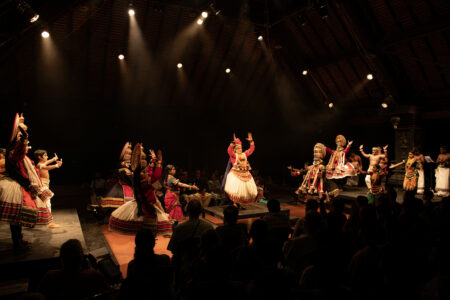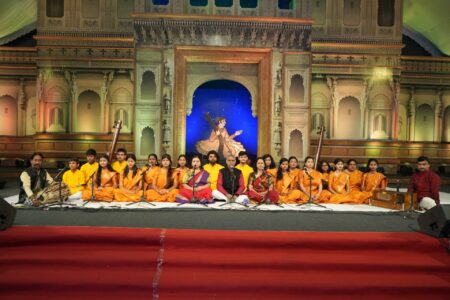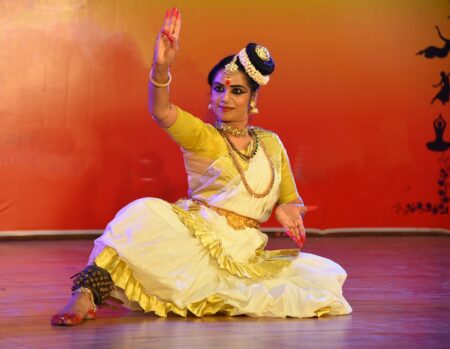The Kala Chethena Kathakali Company designed educational programmes, workshops, demonstrations and organised tours to the cities, towns and small villages, taking Kathakali directly to the heart of the UK audience.
The first thing that had to be changed was to develop a detailed educational programme of workshops. The workshops had to be specially designed to engage all ages to include primary school children, university students, professional artists, teachers, families, people from India and other cultural backgrounds.
Each group needed a workshop that was of interest to them, guiding them through the learning process and lack of understanding until Kathakali made sense.
We planned and structured workshops, assessed if the sessions worked or not, encouraged creativity by exploring knowledge but not by mere imitation.
We worked with people with learning difficulties who experienced life visually and through their senses. People who were deaf were fascinated by the mudras, emotions, exaggerated body language and stylised characters. They were invited back-stage to meet the artists and were delighted to experience a form of theatre that used sign language. They listened to the music through the vibration that travelled through their handbags on the floor and into their hands.
People who were blind were invited to feel the texture of the costumes, hear the voices of the artists and familiarise themselves with the stage. They could feel the movement of air when the artists moved.
Connecting with the audience
As the years passed more and more people started understanding and enjoying Kathakali, the continual hard work was paying off. We encouraged people to see the makeup process, meet the artists and share their experiences of Kathakali. The audiences loved the colours, but some found the drumming too loud and Kathakali too static. They didn’t understand the characters and felt the performances were too long.
It was clear that there was a lot more work to do in linking Kathakali to the UK audience. There was no way that we were going to westernise Kathakali so the answer had to be more on education.
Groups that had received a workshop were able to identify the characters, the emotions and some of the mudras. It was interesting to hear children, who had done a workshop, explaining what was happening on stage to their parents. An exchange of knowledge was happening within the community and a way for Kathakali to develop in this country was made.
Over the next 34 years the Kala Chethena Kathakali Company provided over 4,500 workshops, 3,500 solo performances, 23 exhibitions and 2,000 full company performances all over the UK.
Deeper inroads
As the years turned into decades a following of dedicated people of all ages, cultural backgrounds and abilities started to travel miles to watch Kathakali. We started inviting top artists to tour the UK including the world renowned, Padmasree Kalamandalam Gopi, Kalamandalam Nelliyode Vasudevan Namboodiri, Sadanam Krishnan Kutty, Kottakkal Chandrasekharan Nair, Kalamandalam Vasu Pisharoty, Kalamandalam K G Vasudevan and Kalamandalam Balasubramanian.
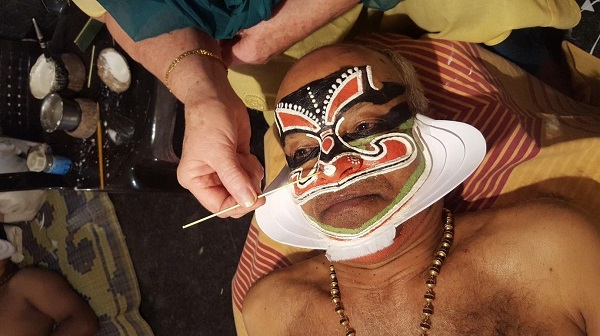
As a touring theatre Company we took quality Kathakali directly to the heart of the people from remote islands, the Highlands of Scotland, cities and towns where Kathakali had never been experienced before. Veteran Kathakali artists travelled along a single track road to perform in a village in the highlands of Scotland, visited the Isles of Scilly, sharing a Kerala meal on the beach, visiting small village halls, cities and towns to bring Kathakali to over 250,000 people.
Making a link with the audience was an essential part of building Kathakali in Britain.
Bringing in the culture
Over the years we have also brought Bharatanatyam, Mohiniattam, Theyyam, Panchavadiyam, Ottanthulal, Thayambaka and Kalamezhuthu to Britain to enrich this country with the remarkable culture of Kerala.
There were many challenges as well. In 2010 we were lucky to get the artists back to Kerala when a heavy snowfall caused most roads to be blocked except the road back to Heathrow airport.
Slowly, our efforts were paying off. Once for a program in one small village, families arrived with small babies. There were very young children under the age of four. We wondered how they would stay focused throughout a Kathakali play. But, the children were captivated. They shared what they were experiencing with their friends, some danced to the drumming and some were copying the mudras. At the end of the performance the audience didn’t just cheer and clap, they jumped up and down and gave a standing ovation.
The change
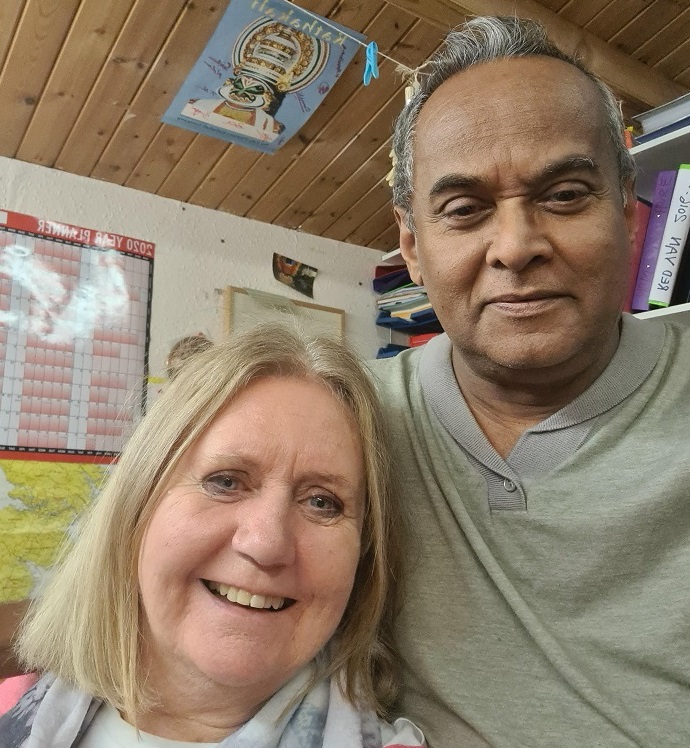
Standing ovations were becoming a normality at the end of the performances when the audience rose to their feet and the cheering erupted with appreciation.
Making Kathakali accessible in the UK, and overseas, was the real success of our work as we slowly turned the UK from an alien place to the principal home of Kathakali outside India. We continued to take Kathakali into small rural areas as well as the major cities such as London, Glasgow, Newcastle on Tyne, Manchester, Southampton, Birmingham and so on.
We made films to be shown before the performance to help the audience understand the temple culture of Kathakali, how the characters are prepared and the story they are to see in the performance. The film was a breakthrough as people were able to access the story and understand the characters through film.
It was essential that we preserved the sacred culture of Kathakali in the UK and therefore respect for the stage was important. The sacred lamp was lit to specially composed music incorporating flute and voice to create a temple culture in which Kathakali was to be experienced. In addition to the synopsis the film created an appropriate, and informed atmosphere to discover the incredible world of Kathakali.
Dictionary of mudras
The final door into the ancient language of Kathakali was opened creating the first digital interactive Dictionary of Kathakali Mudras by Vijayakumar. This dictionary would enable anyone, anywhere in the world, to learn the sign language of a Kathakali play. Apart from this Vijayakumar also shares lessons in Kathakali Mudras on YouTube to help people to understand the stylised language of Kathakali. Anyone can visit to learn this sign-language.
Kathakali will survive the changes of time because it has its roots in our most basic instincts, to explore our emotions, learn how to relate to others and understand that our actions have consequences.
We are grateful to the Arts Council of England, The National Lottery Heritage Fund, sponsors, artists and backstage for making the UK the home of The Kala Chethena Kathakali Company.
Read Part 1

